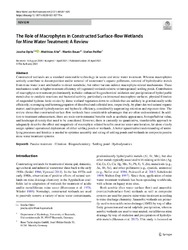The Role of Macrophytes in Constructed Surface-flow Wetlands for Mine Water Treatment: A Review
DOI: https://doi.org/10.1007/s10230-021-00779-x
Persistent URL: http://resolver.sub.uni-goettingen.de/purl?gldocs-11858/11162
Persistent URL: http://resolver.sub.uni-goettingen.de/purl?gldocs-11858/11162
Opitz, Joscha; Alte, Matthias; Bauer, Martin; Peiffer, Stefan, 2021: The Role of Macrophytes in Constructed Surface-flow Wetlands for Mine Water Treatment: A Review. In: Mine Water and the Environment, Band 40, 3: 587 - 605, DOI: 10.1007/s10230-021-00779-x.
 |
Dokument öffnen: |
Constructed wetlands are a standard sustainable technology in waste and mine water treatment. Whereas macrophytes actively contribute to decomposition and/or removal of wastewater’s organic pollutants, removal of hydrolysable metals from mine water is not attributable to direct metabolic, but rather various indirect macrophyte-related mechanisms. These mechanisms result in higher treatment efficiency of (vegetated) wetlands relative to (unvegetated) settling ponds. Contribution of macrophytes to treatment predominantly includes: enhanced biogeochemical oxidation and precipitation of hydrolysable metals due to catalytic reactions and bacterial activity, particularly on immersed macrophyte surfaces; physical filtration of suspended hydrous ferric oxides by dense wetland vegetation down to colloids that are unlikely to gravitationally settle efficiently; scavenging and heteroaggregation of dissolved and colloidal iron, respectively, by plant-derived natural organic matter; and improved hydrodynamics and hydraulic efficiency, considerably augmenting retention and exposure time. The review shows that constructed surface-flow wetlands have considerable advantages that are often underestimated. In addition to treatment enhancement, there are socio-environmental benefits such as aesthetic appearance, biotope/habitat value, and landscape diversity that need to be considered. However, there is currently no quantitative, transferrable approach to adequately describe the effect and magnitude of macrophyte-related benefits on mine water amelioration, let alone clearly assign optimal operational deployment of either settling ponds or wetlands. A better (quantitative) understanding of underlying processes and kinetics is needed to optimise assembly and sizing of settling ponds and wetlands in composite passive mine water treatment systems.


